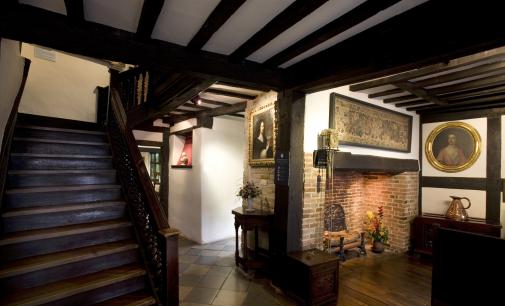Read the Excerpt From the Time Traveler's Guide to Elizabethan England. Eight Years
Time Traveling to Elizabethan England
By Steffi Porter
What practise you need to know in order to make information technology in Elizabethan England?
The Fourth dimension Traveler'due south Guide to Elizabethan England by Ian Mortimer will tell you lot everything yous demand to and want to know. Chock full of historical information, interesting tidbits, and fascinating, niggling-known facts, this book will brand yous wish you could actually travel back to the Elizabethan era. Considering at present you are so well prepared for it!
Everything from traveling through Elizabethan England to the specifics of etiquette, religion, what to wear, and where to stay, just almost all you could need to know is covered. Fifty-fifty what you could go sick from, or how you could get in problem with the law. Mortimer has thought of everything.
Transportation in Elizabethan England: Excerpt from the Book
Road Transport
The use of the word "route" as a noun is an Elizabethan invention, occasionally to be heard from the 1560's onward. The terms "highway," "path," "lane," "street," and "manner" are more unremarkably used. However, any you call them, roads themselves are among the oldest parts of the human being-fabricated landscape. Many of the routes in utilise date from Roman times.

Fifty-fifty in a city, whose houses are rebuilt over and over again, the twists and turns of ancient paths lie like ghosts between the irresolute structures. And ship along these roads is similarly unchanging.
Continuing at a town gate on market day y'all'll still see hundreds of people budgeted–driving cattle or sheep, leading carts laden with sacks and crates, or walking with baskets on their arms or on their heads (holding it in place with a wreath of hay).
In the regal household, coaches are referred to as "close cars" ("shut" meaning "enclosed," as opposed to open up to the elements). Most Londoners refer to them as caroches–a abuse of the Italian carrozze, which are stately carriages for the very wealthy.
Initially, the task of making the royal close cars falls to the royal wheelwright; just in 1569 it goes to a designated "coachmaker," William Rippon, who has been producing coaches for the aristocracy for several years.
The queen has four made for her betwixt 1578 and 1586; they all have timber bases with fe frames forming the superstructure, sides of leather, and linings of linen, and brightly painted cerecloth. They have locking doors, for her majesty'south security.
When the queen goes on a royal progress, she may accept between three and iv hundred carts and wagons with her, using up to xx-four hundred horses; just her own presence consists of her personal bus, a spare one (if the first should break down), and what nosotros might call the "royal convenience" motorcoach, containing a close stool (portable toilet) in case the queen or any of her ladies in waiting is caught brusk when traveling.
The Land of the Roads
The driver who refuses to drive his cart along a certain road is not only being precarious. Roman and medieval roads were intended for people with animals on foot, not for coaches with atomic number 26-tired wheels. According to William Harrison, "In the clay or cledgy soil [the roads] are very deep and troublesome in the winter one-half."

In towns, too, the vast majority of roads are not paved. Gravel is put down at the worst-affected junctions to soak up the mud, but otherwise, carts must laissez passer over deep ruts of dry mud or soft wet soil.
Whatsoever extant stones of Roman paved roads about the surface are probable to be more of a hindrance than a assist for a coachman.
Landowners are tenants of state bordering on the highways are meant to maintain the ditches which bleed the roads but they do not always do so.
Once soaked by a blocked drain, the road quickly turns into a quagmire.
Driving a coach or cart through a town is but as hazardous. Many people have nowhere to stack firewood other than in the street, sometimes nether the eaves of their houses just sometimes partly blocking the fashion.
Many towns take bylaws forbidding this; yet, it is a perennial problem.
Crates, branches, trunks of copse, broken wagons awaiting repairs, split timber, barrels, troughs are all likely to exist constitute in the streets. People dig in the roads for sand or clay to daub their wattle buildings and leave peachy holes.
Sawpits, oft more than 6 anxiety deep are no less dangerous, especially where dug straight beside the road so that the large trunks tin can be easily offloaded. People are fined for excavation wells in or merely beside the highway; in 1573 a servant girl of Rettendon falls into a roadside well and drowns.
Horses
You will need a horse if you intend to travel along the roads of England. Information technology is all very well proverb that y'all don't mind walking and would quite like the practise-many people do walk the length and breadth of the country–merely you lot will shortly encounter the reason in having a mount. It has less to practice with energy expenditure than status and keeping make clean.
Gentlemen and ladies do not walk along the highways: they either ride or are carried in a bus. The only other pick is a litter. This is a compartment or carriage supported on ii long poles. In towns it might exist carried by servants: some women utilise them for shopping in preference to a bus, being easier to maneuver in the streets of a city.
Traveling any distance, notwithstanding, volition crave yous to take a horse harness for the litter. Although erstwhile-fashioned in comparing with the coaches, they are still in utilize among the aristocracy.
Buy The Time Traveler'due south Guide to Elizabethan England on Amazon.

Ian Mortimer is a British author of historical fiction and historian best known for his book The Time Traveler'southward Guide to Medieval England.
Love England? Get our England Airplane Reader for dozens of stories about the UK for your Kindle, or iPad.
Source: https://www.gonomad.com/5491-time-travelers-guide-elizabethan-england

0 Response to "Read the Excerpt From the Time Traveler's Guide to Elizabethan England. Eight Years"
Post a Comment